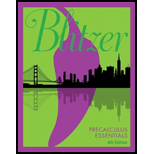
To calculate: The length of triangle to the nearest tenth and angle measure to the nearest degree whose angles and side is
Answer to Problem 1RE
Solution: The missing values are:
Explanation of Solution
Given Information: The values:
Formula used:
Calculation:
For any triangle,
The Law of sine states:
Using the angle sum property we will obtain:
Using the law of sines we get,
This gives
Also,
This gives
So,
Hence,
Want to see more full solutions like this?
Chapter 6 Solutions
Blitzer: Precalculus Essentials_5 (5th Edition)
- Please focus on ix.arrow_forwardPlease focus on vi.arrow_forward的 v If A is an n x n matrix that is not invertible, then A. rank(A) = n C. det(A) = 0 B. Reduced row-echelon form of A = In D. AB BA= In for some matrix B 63°F Partly sunny Q Search 3 $ 4 40 FS 96 S W E A S T FG S Y & コ B ㅁ F G H J 4 Z X C V B N M 9 H V FIB - FIB ㅁ P L ว DELETE BACHSPACE LOCK L ? PAUSE ALT CTRL ENTER 7 2:20 PM 4/14/2025 HOME J INSERT SHIFT END 5arrow_forward
- i Compute the given determinant by cofactor expansions. At each step, choose a row or columnthat involves the least amount of computation.7 6 8 40 0 0 68 7 9 30 4 0 5arrow_forwardi Compute the inverse of the matrix below using row operations. Please show your work.1 0 −2−3 1 42 −3 4 This is a 3*3 matrix. First row is 1 0 -2.arrow_forwardSolve the system of equations below by applying row operations on the corresponding aug-mented matrix to convert it to the reduced row-echelon form. Write the solutions using freevariables as parameters.x1 + 3x2 + x3 = 1−4x1 − 9x2 + 2x3 = −1−3x2 − 6x3 = −3arrow_forward
 Calculus: Early TranscendentalsCalculusISBN:9781285741550Author:James StewartPublisher:Cengage Learning
Calculus: Early TranscendentalsCalculusISBN:9781285741550Author:James StewartPublisher:Cengage Learning Thomas' Calculus (14th Edition)CalculusISBN:9780134438986Author:Joel R. Hass, Christopher E. Heil, Maurice D. WeirPublisher:PEARSON
Thomas' Calculus (14th Edition)CalculusISBN:9780134438986Author:Joel R. Hass, Christopher E. Heil, Maurice D. WeirPublisher:PEARSON Calculus: Early Transcendentals (3rd Edition)CalculusISBN:9780134763644Author:William L. Briggs, Lyle Cochran, Bernard Gillett, Eric SchulzPublisher:PEARSON
Calculus: Early Transcendentals (3rd Edition)CalculusISBN:9780134763644Author:William L. Briggs, Lyle Cochran, Bernard Gillett, Eric SchulzPublisher:PEARSON Calculus: Early TranscendentalsCalculusISBN:9781319050740Author:Jon Rogawski, Colin Adams, Robert FranzosaPublisher:W. H. Freeman
Calculus: Early TranscendentalsCalculusISBN:9781319050740Author:Jon Rogawski, Colin Adams, Robert FranzosaPublisher:W. H. Freeman
 Calculus: Early Transcendental FunctionsCalculusISBN:9781337552516Author:Ron Larson, Bruce H. EdwardsPublisher:Cengage Learning
Calculus: Early Transcendental FunctionsCalculusISBN:9781337552516Author:Ron Larson, Bruce H. EdwardsPublisher:Cengage Learning





